20 Examples Of How To Address a Cover Letter to an Unknown Recipient
Introduction.
Imagine sending out dozens of job applications, only to realize that you've been addressing your cover letters incorrectly. As it turns out, addressing a cover letter to an unknown recipient can be a tricky task. In this comprehensive guide, we'll provide strategies for finding the right name, using job titles as an alternative, formatting the letter, avoiding common mistakes, leveraging professional networking, and understanding the importance of personalization. By following our advice, you can increase your chances of landing that job interview and making a great first impression.

Finding the Right Name
Before you give up on finding the recipient's name, consider these research strategies:
Check the job post for a specific name. Sometimes, the name of the hiring manager or contact person is listed in the job posting. Read the post carefully to see if a name is mentioned.
Search the company website for a company directory or listing of key personnel. Many organizations have a "Meet Our Team" or "About Us" section that introduces their staff members. Look for someone with a relevant title, such as "Hiring Manager" or "Human Resources Director."
Call the company directly and ask for the appropriate contact person. If you're unable to find the name online, consider calling the company and asking for the name of the person responsible for hiring for the position you're applying for. This approach can be particularly effective for smaller organizations.
Utilize professional networking platforms like LinkedIn to find the recipient. LinkedIn is a powerful tool for job seekers. Try searching for employees at the company with relevant titles, then check their profiles for clues about their role in the hiring process. You can learn more about how to find the name of the hiring manager using LinkedIn in this helpful article.
Personalize your cover letter. Addressing your cover letter to a specific individual shows that you've done your homework and are genuinely interested in the position. This extra effort can make a big difference in how your application is perceived by the recipient.
Using a Job Title
If you're unable to find the recipient's name, consider using a job title or department head as an alternative:
Address the letter to the job title of the reader. For example, you might write "Dear Hiring Manager" or "Dear Human Resources Director." This approach is more specific and professional than using a generic greeting like "To Whom It May Concern."
Consider addressing the letter to the head of the department where you're applying to work. If you know the department your job falls under, try addressing your cover letter to the department head, such as "Dear Marketing Director" or "Dear IT Manager."
Explain why using a job title or department head can still demonstrate professionalism and personalization. Although it's not as ideal as using a specific name, addressing your letter to a relevant job title shows that you've put some thought into your application and have a clear understanding of the company's structure.
Provide examples of different job titles to use as salutations. You can find a list of different job titles to use as salutations in this resource.
Discuss the potential impact of using job titles on the success of the job application. While using a job title may not guarantee success, it can increase your chances of making a favorable impression. A personalized salutation indicates that you're genuinely interested in the position and have taken the time to research the company.
Formatting the Letter
When addressing a cover letter to an unknown recipient, follow these formatting tips:
Always use "Dear" to start the address. This is a professional and respectful way to begin a cover letter.
Use a gender-neutral title (such as Ms.) if the recipient's gender is unknown. If you're unsure of the recipient's gender, it's better to use a neutral title like "Ms." rather than making assumptions.
For non-gender-specific names, use the recipient's full name. If you can't determine the recipient's gender based on their name, address the letter using their full name, such as "Dear Taylor Smith."
Maintain a professional tone even when the name is unknown. Even if you don't know the recipient's name, it's crucial to keep your language and tone professional throughout your cover letter.
Provide examples of well-formatted cover letter salutations.
While it's always best to try and find the name of the hiring manager or recruiter, there may be times when you just can't find that information. Don't let it deter you. Below are 20 examples of how you can address your cover letter when the recipient is unknown:
1. Dear Hiring Manager, 2. To the Recruitment Team, 3. Dear Human Resources Team, 4. Attention Hiring Committee, 5. Dear [Job Title] Hiring Team, 6. To the [Company Name] Team, 7. Dear [Company Name] Recruiter, 8. To Whom It May Concern, 9. Dear Hiring Authority, 10. Attention [Company Name] Hiring Professionals, 11. Dear Talent Acquisition Team, 12. Hello [Company Name] Selection Panel, 13. Dear Recruitment Advisor, 14. To the [Industry] Professionals at [Company Name], 15. Attention [Company Name] Talent Scouts, 16. Dear Hiring Advocate, 17. To the Selection Committee for [Job Title], 18. Dear [Company Name] Staffing Team, 19. Attention [Job Title] Recruitment Panel, 20. Dear [Company Name] Hiring Panel,
Remember, the goal is to be as respectful and professional as possible in your salutation. Even if you don't know the recipient's name, demonstrating courtesy in your greeting will set a positive tone for the rest of your cover letter.
Also, avoid overly casual greetings like 'Hello' or 'Hi there,' which might seem unprofessional, and stay clear of outdated phrases such as 'Dear Sir or Madam.' Instead, opt for more modern, inclusive alternatives. Be sure to follow your greeting with a comma or a colon, then leave a space before starting the body of your letter.
Avoiding Common Mistakes
When addressing a cover letter to an unknown recipient, it's essential to avoid these common mistakes:
Using generic greetings like "To Whom It May Concern." This phrase is outdated and impersonal, and using it can make your application seem generic and unprofessional. Instead, try to find a specific name or use a job title, as discussed in previous sections.
Using incorrect titles or making assumptions about the recipient's gender. Making assumptions about someone's gender or using an inappropriate title can potentially offend the recipient and hurt your chances of landing an interview. Stick to gender-neutral titles or use the recipient's full name when in doubt.
Addressing the letter to the wrong department or job title. Be sure to double-check that you're addressing your letter to the appropriate person or department. Sending your application to the wrong person can result in your application being overlooked or discarded.
Failing to proofread the cover letter for errors, even in the salutation. Typos and other errors can make a poor impression on the recipient. Be sure to proofread your entire cover letter, including the salutation, before submitting it.
Provide examples of mistakes that could hurt the applicant's chances of landing an interview. Some examples of common errors include misspelling the recipient's name, using an informal greeting (such as "Hey"), or addressing the letter to an unrelated department (e.g., "Dear Accounting Manager" when applying for a marketing position).
Utilizing Professional Networking
Leveraging your professional network can be an effective way to find the name of the recipient for your cover letter:
Use platforms like LinkedIn to research the company and its employees. As mentioned earlier, LinkedIn is a valuable resource for job seekers. You can use the platform to find employees with relevant titles, learn more about the company culture, and even discover mutual connections who might be able to provide an introduction or additional information.
Connect with current employees or alumni of the company. Networking with people who work at the company or have worked there in the past can give you valuable insights into the hiring process and help you identify the appropriate contact person for your cover letter.
Search for the appropriate contact person within your professional network. Use your connections to find people who work at the company you're applying to, and ask if they know who the hiring manager for your desired position is.
Networking can help job seekers get noticed by potential employers. Building relationships with people at the company can increase your chances of getting noticed and potentially even lead to a referral. Learn more about how networking can help job seekers get noticed by potential employers in this article.
Offer examples of successful job seekers who found the recipient's name through networking. For instance, this cover letter that landed a job seeker a role at LinkedIn is a great example of how personalizing your cover letter and leveraging your network can help you stand out.
Importance of Personalization
Personalizing your cover letter can make a significant difference in the success of your job application:
Discuss the impact of personalization on the reader's impression of the applicant. A personalized cover letter demonstrates that you've done your research and are genuinely interested in the position, which can make a positive impression on the recipient.
Provide statistics on the success rate of personalized cover letters compared to generic ones. According to resume statistics , candidates with typos in their cover letters or resumes are 58% more likely to be dismissed, while those who do not include specific employment dates are 27% more likely to be dismissed.
Offer expert opinions on the importance of addressing cover letters to specific individuals. Many career experts agree that addressing cover letters to specific individuals can increase your chances of landing an interview.
Explain how personalization demonstrates research skills and genuine interest in the company. Taking the time to research the recipient and tailor your cover letter to the specific position and company shows that you're not only a thorough and detail-oriented candidate, but also genuinely interested in the opportunity.
Share anecdotes of successful job seekers who personalized their cover letters and landed interviews. For example, one job seeker found the recipient's name through LinkedIn and personalized his cover letter , which helped him land an interview and ultimately secure the position.
Conclusion and Final Thoughts
In summary, addressing a cover letter to an unknown recipient can be challenging, but by following our tips and strategies, you can make a strong impression on potential employers. Remember to:
- Research the recipient's name or use a relevant job title.
- Personalize your cover letter to demonstrate genuine interest in the position.
- Maintain a professional tone and formatting throughout your cover letter.
- Avoid common mistakes that can hurt your chances of landing an interview.
- Leverage your professional network to find the appropriate contact person.
By applying these tips to your job search, you'll increase your chances of success and make a lasting impression on potential employers. Good luck with your job applications!
- Search Search Please fill out this field.
- Career Planning
- Finding a Job
- Cover Letters
How to Write a Cover Letter for an Unadvertised Job
Job Application Letter Sample and Writing Tips for a Role That's Not Advertised
:max_bytes(150000):strip_icc():format(webp)/ADHeadshot-Cropped-b80e40469d5b4852a68f94ad69d6e8bd.jpg)
- Tips for Writing Your Cover Letter
What to Include in Your Cover Letter
- Cover Letter Example and Template
Proofread Your Documents
How to send your letter.
- How to Send Your Resume
Shapecharge / E+ / Getty Images
How do you write a job application letter for a role that isn't listed? Not all companies advertise job openings. Some companies get plenty of applicants without advertising. Other companies may not be in hiring mode but will consider applications from qualified candidates if they anticipate an opening in the near future.
Sending a resume and cover letter to an employer, even though you aren't sure if there are available jobs, is a way to get your candidacy noticed. It may also get you advance consideration for positions that have just opened up. If you have the skills the company needs, it may even get you considered for a brand-new position.
When you know an employer has an opening, don't hesitate to apply.
If you have a company you'd love to work for , consider taking the time to reach out and connect regardless of whether the organization is currently hiring.
Tips for Writing a Cover Letter for an Unadvertised Job
What's the best way to apply for unadvertised job openings? It depends on whether you know there is a position available, but the company hasn't listed it, or if there's a company you want to work for and you don't know if there are open jobs.
Kelly Miller / The Balance
When You Know There Is a Job Opening
If you know the company is hiring but hasn't advertised the position, write a traditional cover letter expressing your interest in the open position at the company. Be sure to specifically relate your qualifications for the job.
When You Don't Know If the Company Is Hiring
Writing a cover letter for an unadvertised opening (also known as a cold contact cover letter or letter of interest ) is a little different than writing a cover letter for a job that you know is available.
With this type of letter, you will need to make a strong pitch for yourself and how you can help the company. Below are some tips on how to write a cover letter for an unadvertised opening.
- Mention your contacts. If you know someone at the organization, mention this at the beginning of the cover letter. Having a contact at the company is a great way to get your foot in the door, even if the company isn’t actively hiring.
- Use paper or email. You can send your letter via paper or email . Sending an old-fashioned paper letter works well for this type of letter , because it may have a better chance of being read than an email, which could be deleted without even being opened.
- Include a resume. Whether you send your cover letter via paper or email, be sure to include a copy of your resume. Make sure you tailor your resume to the company and type of job you are looking for.
Below is detailed information on what to include in your cover letter, along with links to example cover letters.
Your Contact Information Name Address City, State Zip Code Phone Number Email Address
- Cover Letter Contact Section Examples
Greeting If you can find a contact person at the company, direct your letter or email message to them. Here's how to find contacts at companies .
If you can't locate a contact person, address your letter to "Dear Hiring Manager" or leave out this section and start with the first paragraph of your letter.
- Cover Letter Greeting Examples
Body of Cover Letter The goal of your letter is to get noticed as a prospective employee even if the company isn't hiring immediately. Your letter should explain the reason for your interest in the organization, identify your most relevant skills or experiences, and explain why you would be an asset to the company.
First Paragraph: The first paragraph of your letter should include information on why you are writing. If you know someone at the company, mention it now. Be specific as to why you are interested in this particular company.
Middle Paragraph(s): The next section of your cover letter should describe what you have to offer the employer. Again, be specific as to how you can help the organization.
Final Paragraph: Conclude your cover letter by thanking the employer for considering you for employment.
- What to Include in the Body Section of a Cover Letter
Closing Best Regards, (or choose another closing from the examples below)
- Cover Letter Closing Examples
Signature Handwritten Signature (for a mailed letter)
Typed Signature When you are sending an email letter, be sure to include all your contact information in your signature.
- Signature Examples
Cover Letter Example for a Job That's Not Advertised
You can use this sample as a model to write a cover letter. Download the template (compatible with Google Docs and Word Online), or read the text version below.
Cover Letter for a Job That's Not Advertised (Text Version)
Your Name Your Address City, State Zip Code Your Phone Number Your Email Address
Contact Name Title Company Address City, State Zip Code
Dear Mr./Ms. LastName,
As an Information Technology professional with high-level management experience in the IT industry, I learned that the best way to achieve success was to motivate the resources I had with well-defined objectives and empowerment.
A management belief based on integrity, quality, and service, along with a positive attitude, an aptitude for strategic thought and planning, and the ability to adapt quickly to new ideas and situations allows me to achieve consistent and significant successes in multiple industries.
My personality profile says:
- A confident, driven individual who reacts quickly to change.
- A self-starter with a strong sense of urgency who responds positively to challenge and pressure.
- A fast learner who is a practical and ingenious problem solver.
- A fluent and articulate communicator, flexible and responsive. A self-directed, goal-oriented doer.
My former managers say:
"The Information Technology Analysis will serve as a guideline for making positive contributions... Your management style provided a footprint for younger members of our organization... a very positive impression of the contributions you made to our business and its growth." Gregory Hines, President and CEO, Information Data Technology.
"The most important source of growth in our data technology business ... able to focus the team and manage the product to a successful introduction ... due in large part to his own personal commitment ... excellent IT project management and operational management skills." Pauline Hallenback, CTO at Information Systems.
"Your strengths as a manager are many and varied... all issues are confronted in a timely manner ... management by objectives comes as a second nature to you." Jackson Brownell, Director of Operations, Denver Technologies.
ABC Company is a company that would provide me with the opportunity to put my personality, skills, and successes to work. At a personal meeting, I would like to discuss with you how I will contribute to the continued growth of your company.
Best regards,
Carefully proofread both your resume and cover letter before you send them. Here are proofreading tips for job seekers.
When sending your letter via email, write your letter in the email message and attach your resume to the message. In the subject line, put your name and the reason for writing (Your Name - Introduction).
- Email Subject Lines
How to Send Your Resume With Your Cover Letter
Here's how to send your resume with your cover letter:
- How to Email Your Resume
- How to Send Your Resume as an Attachment
- How to Mail a Resume and Cover Letter
Key Takeaways
Take initiative. Not all companies immediately advertise opening positions. Taking the initiative to send a cover letter of introduction “on spec” may garner you an interview for either an existing or a newly developed job role.
Apply to your dream company. Nothing ventured, nothing gained. If there is a company you’ve always wanted to work for, reach out to their hiring department with a strategic letter that presents your qualifications and interest in their organization.
Build upon your contacts. A good way to get your foot into the door at a company is to begin your letter of introduction by mentioning the contacts you know who work there. Take this to the next level by proactively asking these contacts—before you send your cover letter—if they would be willing to put in a good word on your behalf with their employer.
How to address cover letter without a name
Imagine that you’ve found a position you want to apply for and are working through your cover letter. There’s just one problem — you’re not sure how to address your cover letter. Unknown recipients can complicate the application process, especially when you want to set a great first impression. If you’re wondering who to address cover letter to if unknown, it’s important to find an alternative solution that is professional and respectful. Here’s what you need to know.
Unknown recipient: What you can do about it
Chances are that you’ve been searching “how. to address cover letter without name” or “unknown recipient cover letter” after encountering this scenario. The good news is that there are multiple solutions to this conundrum.
If you need to write a cover letter to an unknown party, you should:
Research the company
You should be researching any prospective employer before submitting an application so that you can learn more about their values, organizational structure, and culture. By digging a little deeper, you can usually find some basic information about the head of HR or the appropriate contact person.
This information is usually located on the company’s website or the hiring manager’s LinkedIn. If you search the company, their account should be associated with it.
If necessary, call the business. Give them your name, let the person who answers know that you are submitting an application, and ask who to address the documents to.
Customizing your resume and cover letter for each job application will help you stand out and may increase your odds of landing an interview. Doing the legwork and finding out the name of the hiring manager is a great way of customizing your application, and it shows that you are a self-starter.
Use generic salutations
You will also want to consider how to address a cover letter without a name. If you can’t track down contact information for the person in charge of hiring, use a generic salutation. A few favorites include:
- Dear Hiring Manager
- Dear Recruiting Team
- To Whom It May Concern
However, be careful not to overuse these phrases, as doing so can make your letter feel generic. Instead, use one of these phrases at the opening of your cover letter and keep your sentence phrasing focused on you and the business as a whole throughout the rest of the document.
Need some more inspiration for creating a great introduction? Check out our cover letter examples and resume examples . These free resources can jumpstart your job search efforts and help you land an interview.
Personalize your greeting
When deciding who to address cover letter to if unknown, it’s vital to get creative with your personalization. Do your best to track down an HR department head or hiring manager’s contact information. If you simply cannot, personalize your content by referencing recent company news or mutual connections.
You can still create a great cover letter without a personalized greeting. However, you need to make at least some aspects of your document feel tailored to the job and organization you are applying to. You don’t want hiring personnel to believe that you submitted an identical document to multiple businesses.
For more detailed tips and tricks, check out our growing library of cover letter articles . You’ll find everything from resume templates to job-specific cover letter examples, as well as best practices, dos and don’ts, and more!letter
Expert Tip:
Creating a cover letter with unknown recipients will not be a barrier to getting the job, provided you adhere to established best practices, research the business you are applying for, and personalize your documents to demonstrate your desire to join the organization.
Avoid common mistakes
Creating a cover letter without knowing the recipient’s name can be challenging, but it’s crucial to avoid common pitfalls that could undermine your application. Here are some common mistakes to avoid:
Using outdated or incorrect titles
One of the most common errors in addressing a cover letter involves using outdated or incorrect titles. Avoid using generic titles like “Dear Sir/Madam.” Instead, take the time to research the company or department structure to determine the appropriate title to use. Using the wrong title can convey a lack of attention to detail and professionalism.
If you can’t find the person’s name, it’s acceptable to use a generalized title, such as “Hiring Manager” or “Human Resources Manager.” Tailor the title you use based on the size and structure of the company.
Misspelling names or titles
Another common mistake is misspelling names or titles. Double-check the spelling of the recipient’s name and any titles before sending your cover letter.
Misspelling a name can make a negative impression and suggest carelessness. If you’re unsure of the correct spelling, consider reaching out to the company or using a neutral salutation like “Dear Hiring Manager.”
Remember, the recipients are going to draw several conclusions about you based on your cover letter and resume. In addition to running spell checks, consider using matching resume and cover letter templates to ensure consistency across both documents.
Our resume articles offer additional insights that can assist with preventing mishaps and making your application more impactful.
Making assumptions about the recipient’s gender
Assuming the gender of a recipient based on their name can also be a mistake. In today’s diverse workplaces, it’s essential to avoid making assumptions about gender.
Instead of using salutations like “Dear Sir” or “Dear Madam,” opt for gender-neutral alternatives like “Dear Hiring Manager” or “Dear [Company Name] Team.” This demonstrates respect for all individuals and avoids potential offense.
More importantly, using gender-neutral language demonstrates that you are an emotionally intelligent and considerate person. Hiring teams are considering more than just your skill set. They want to make sure you will have good chemistry with existing employees.
Failing to research the company
Failing to research the company before addressing your cover letter is one of the worst mistakes you can make. Take the time to learn about the company’s culture, values, and organizational structure. This information can help you tailor your cover and demonstrate your genuine interest in the company.
Neglecting to customize the cover letter
Failing to customize your cover letter for each job application is another common mistake. Employers can easily spot a generic cover letter.
Take the time to customize your cover letter for each application, highlighting relevant skills and experiences that match the job requirements. This demonstrates your genuine interest in the position and increases your chances of progressing in the hiring process.
“Remember, the recipients are going to draw several conclusions about you based on your cover letter and resume”
In today’s hiring market, you don’t want to simply submit your cover letter and wait around for businesses to contact you. Be proactive and follow up with the human resources department a few days after you apply. Call the company directly, or reach out via email.
When you do reach out, be direct. Consider saying something like, “I am reaching out about the status of my application, which was submitted on [D ate of Submission]. I look forward to continuing the hiring process and participating in an interview.” This reply demonstrates confidence and genuine interest without overplaying your hand.
If you speak to someone on the phone, use a similar approach. However, it’s best not to be rigid. Aim to be kind and personable, as the person you speak to may be directly involved in the interview and vetting process. If it is a smaller business, you may even end up speaking directly to the person in charge of hiring.
Keep in mind that it’s acceptable to follow up multiple times. Generally, you should reach out two to three days after your initial application and roughly a week later if you still haven’t heard anything definitive.
Crafting a compelling letter for an unknown recipient
Many applicants wonder who to address cover letter to if unknown recipient. But no matter who the intended recipient is, creating a dynamic cover letter requires diligence and discipline. Be willing to research your prospective employer so that you can learn more about the organization and who will be involved in your interview process.
Doing some extra work to make your application stand out can mean the difference between getting an interview or having your letter get lost among other job seekers.
If you’d like to learn more about how to create a more appealing application, Jobseeker can help. We provide free resources, useful templates, and personalized support designed to help you achieve your career goals. Connect with us today!
Get ahead of the competition
Make your job applications stand-out from other candidates.

Video Cover Letters

How to End a Cover Letter With Confidence

How to Write an Effective Academic Cover Letter
Resume builder
How to Address a Cover Letter Without a Name: 5 Best Salutations
Cover letters can be a bit of an art form when they include the proper salutation to their recipient. Since you’re creating your own cover letter and don’t have a name to address it to, you might feel a little stuck.
Don’t worry; there are plenty of ways to still address your cover letter appropriately, even if you don’t have this information readily available.
Let’s take a look at five different ways on how to address a cover letter without a name.

Table of Contents
5 Popular Ways to Address a Cover Letter Without a Name
How long a cover letter should be is important somehow. What matters is that it is addressed directly to someone specific, such as Dear Mr. Jones or Dear Recruiter.
If there is no name in the email asking you to submit your cover letter, then try these five ways on how to address a cover letter without a name:
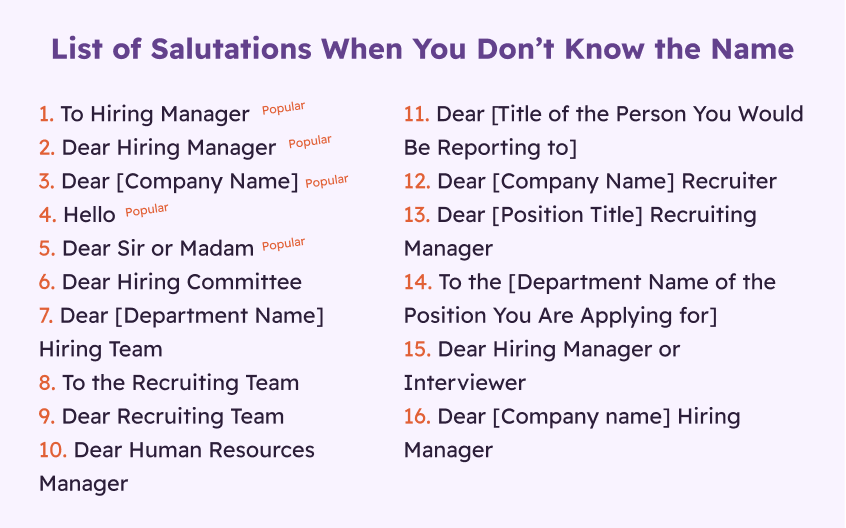
1. To the Hiring Manager
If you don’t know who will be reading your cover letter, it’s best to start with To the hiring manager and follow that up with a more personal introduction. These words should sound professional so that they’re easy for whoever is reading them to digest while they’re reviewing your resume/cover letter.
For example:
To the Hiring Manager: I am writing to you because I am interested in the position of __. I have seen that you are looking for candidates and my qualifications seem to be a good fit. I believe that I have what it takes to do this job well. Please find my CV attached for your review and consideration. Thank you so much for your time, and looking forward to your response. If you have any questions about anything, please feel free to contact me at __. I’m happy to answer any questions and provide additional information as needed.
2. Dear Hiring Manager
It is important to address the cover letter recipient with a formal greeting. And when making cover letters, the most commonly used term is Dear, which is often used before the recipient’s name.
Since this is a formal greeting, any titles that follow should use this style. If possible, avoid salutations that are gender specific. Also, avoid informal salutations, such as those that include the words Hi and Hello.
It is important that you specify what kind of work experience you have in the cover letter and why this job is right for you. Let the Hiring Manager know that they can reach out to you anytime during their application process if they want to talk more about it.
Lastly, make sure that you end your cover letter properly.
Dear Hiring Manager, I hope you’re having a great day! I’m writing in response to your recent posting. My name is __, and I’m excited about the possibility of working with you. I noticed that the company is looking for someone who has experience in __ , and I would love to share my qualifications with you. Feel free to contact me at _ so we can talk more about it. Thank you for your time, and have a great day!
3. Dear [Company Name]
There are a lot of reasons why you might not have a name in your cover letter. Maybe you’re applying for a job, and the company hasn’t been formally named yet, or maybe you’ve applied to an organization that doesn’t use names in their communications.
Whatever the reason, it can be tricky to address your cover letter without a name. But that doesn’t have to be a cause of headaches. In such a case, use Dear Company Name.
- Are Cover Letters Necessary?
- How Long Should a Cover Letter Be?
This option is the best way to go if the company has already publicly announced its name. For example, you can say, “Dear Google”.
For example: Dear Google, I’m writing this cover letter to apply for the __ role. [Add career highlights and other relevant experiences.] Please feel free to reach out to me with any questions that you may have. Enjoy the rest of the day!
Hello is one of the most common ways to address a cover letter without a name. If you are making your cover letter formal, use Dear Hiring Manager, but if you are using a more casual tone, try something like Hello.
If you know who will be reviewing your application, it’s also appropriate to use their name in the salutation.
For example: Hello Hiring Manager, My name is __. I hope you’re doing well. I was reading your job listing and noticed that you’re looking for someone to fill the position of (job title). I’m very interested in this opportunity because __. Thank you for taking the time to read my cover letter, and I’d love to learn more about your company, so feel free to reach out if there’s anything else you need from me!
5. Dear Sir or Madam
Finding the right words when creating a cover letter you will send to an unknown person or company is always difficult. But there are many ways to address your cover letter that will have your potential employer reading it and considering you for the position. Dear Sir or Madam is just one example.
The use of Dear is typically seen as a more formal way to address your cover letter, and Sir or Madam is used when you don’t know the gender of the person reading your correspondence. When in doubt, stick with these two options for addressing a cover letter without knowing the recipient’s name.
However, this is only ideal if you know the gender of the hiring manager but don’t know their name. If you are not sure whether the hiring manager is he or she, consider using a gender-neutral salutation.
Dear Sir/Madam, I hope this letter finds you well. I am writing to apply for the __ position you recently posted on the __ job site. I am confident that my knowledge, skills, and experience would be an asset to your awesome team. I am enclosing my resume/CV for your consideration. Thank you very much for taking the time to read my letter and considering me for this opportunity.
Other Salutations to Use When You Don’t Have a Name
There are many different ways to start a cover letter , but if you don’t have the name of the person you are addressing, then it can be difficult to come up with a good opening.
The most common way to address someone in a cover letter is by using their title and last name. If this isn’t possible, there are other ways that you can use as well. One way is to start off with any of the salutations mentioned above. Another option is to start off with these options:
- Dear Hiring Committee
- Dear [Department Name] Hiring Team
- To the Recruiting Team
- Dear Recruiting Team
- Dear Human Resources Manager
- Dear [Title of the Person You Would Be Reporting to]
- Dear [Company Name] Recruiter
- Dear [Position Title] Recruiting Manager
- To the [Department Name of the Position You Are Applying for]
- Dear Hiring Manager or Interviewer
- Dear Hiring Manager of Company X
- Dear Person in Charge of Hiring
Tips to Find the Names of Employers and Hiring Managers
A cover letter may seem like a small part of the hiring process, but it has an enormous impact on whether or not your resume will even be opened by the company you’re applying to.
One way to ensure your cover letter isn’t ignored is by addressing it properly, which can be difficult if you don’t know to whom you’re writing it!
To help you figure out the name of the cover letter’s recipient , here are some tips:
Tip #1: Check the company’s website.
If you know the company’s name and they have a website with contact information, that’s usually the best place to start.
Tip #2: Review job listing sites.
If you’re applying through an online job application site like Indeed, then there will be an option to check to whom the cover letter will be sent. The job posting usually provides you with the names of employers or hiring managers.
Tip #3: Use LinkedIn.
The easiest way to find out the name of the Hiring Manager is to check LinkedIn. The job posting usually includes information about the Hiring Manager. Visit the profile, where it’ll list their current position as well as past positions on their profile page.
Tip #4: Check the job description.
Check the job description to find the name of potential hiring managers. Sometimes, it’s just there. All you need to do is read through the job posting.
Tip #5: Search social media.
You can probably find the names of recruiters on social media. See Facebook or Twitter for any information you can use in writing the cover letter.
How to Make the Perfect Cover Letter
When sending your cover letter without the name, you must be sure that you are addressing the person who is in charge of hiring. Avoid using To Whom It May Concern at all costs. If it is unavoidable, aim to get personal as soon as possible. If you’re emailing a large company, mention specific people you have spoken with over email or via social media in your letter.
To make the perfect cover letter , use an online cover letter maker. This is the best and easiest way to address your cover letter without knowing the name of the company.
The cover letter maker will have all of your information and personalize it for you. Plus, it will give tips on what to include in your cover letter. An online cover letter maker will walk you through each step and ensure that your cover letter looks professional.
You can also get help from other people who are reviewing cover letters if you need more advice on how to approach this. They will know everything about how these companies operate and be able to provide insight into what might work for them.
Final Thoughts
Writing a cover letter can seem like one of the most time-consuming and overwhelming parts of your job search, especially when you don’t know who the person you’re writing to is. However, cover letters are necessary.
If you don’t know the name of the person you’re writing to, that doesn’t mean you should throw in the towel and not write one at all, though. These five ways on how to address a cover letter without a name will ensure that your application still gets noticed.
10 thoughts on “ How to Address a Cover Letter Without a Name: 5 Best Salutations ”
Aw, this was an incredibly good post. Finding the time and actual effort to produce a good articleÖ but what can I sayÖ I procrastinate a lot and never manage to get anything done.
Great post but I was wanting to know if you could write a litte more on this subject? I’d be very thankful if you could elaborate a little bit further. Thank you!
I guess you can get some more tips from our complete guide “How to Write a Cover Letter” https://resumekit.com/blog/how-to-write-a-cover-letter/
Excellent post. I used to be checking constantly this weblog and I’m inspired! Very helpful info specifically the last section :) I deal with such information much. I used to be seeking this certain info for a long time. Thank you and best of luck.
Thank you so much!
I was able to find good information from your blog posts.
A round of applause for your post. Will read on…
Thanks for finally writing about > How to Address a Cover Letter Without a Name (5 Salutations) mattress near Me
What’s up friends, its fantastic article on the topic of educationand entirely defined, keep it up all the time.
Thanks Tatiana, We will keep on moving :)
Leave a Reply Cancel reply
Your email address will not be published. Required fields are marked *
Save my name, email, and website in this browser for the next time I comment.
The 3 Rules of Addressing Your Cover Letter in 2023

You’ve finally sat down to write that cover letter (good for you!), but immediately you run into a roadblock: How do you even start the darn thing? Who do you address it to? Should you use Mr. or Ms.? Do you include a first name? And what if you’ve searched high and low, but can’t find the hiring manager’s name?
Don’t fret! Follow these three rules for cover letter salutation salvation.
Rule #1: Address your cover letter to the hiring manager using a formal, full-name salutation (if possible).
For a cover letter, you should always default to addressing it to the hiring manager for the position you’re applying to. Unless you know for sure that the culture of the company is more casual, use the hiring manager’s first and last name. You can include a title, such as “Mr.” or “Ms.” (never Mrs. or Miss). But if you aren’t crystal clear on whether to use “Mr.” or “Ms.” and can’t find their pronouns with a little Google and social media searching (and you don’t have an easy way out with a “Dr.”), just drop the title. Omitting it is infinitely better than accidentally misgendering someone .
Most letters I see still use the “Dear” greeting, though I’ve seen a growing trend of people dropping it and starting with “Hello” or just the name. Any of these works. The most important part is having the actual name . Never use “ To Whom it May Concern ” or “Dear or Sir or Madam”—nothing could be more generic (not to mention archaic). Your cover letter could be the first opportunity you have to make an impression on the hiring manager, so make sure you show that you did your research .
For example, you can address your cover letter by saying:
- Dear Ms. Jacklyn O’Connell,
- Hello Mr. Kevin Chen,
- Dear Niko Adamos,
- Hello Jean Butler,
- Tiana Richards,
Rule #2: If you don’t know the hiring manager, guess.
Sometimes, even after hours of online searching ( try these tips ), you still might not be able to definitively figure out who exactly the hiring manager for the position you’re applying for is—and that’s OK.
If you can only find a list of the company’s executive team, use the head of the department for the position you’re applying for. In the end, no one will fault you for addressing the letter higher up than necessary. This approach is definitely better than not using a name in your cover letter, because it still shows the time and effort you took to find out who the department head is.

Rule #3: Be as specific as possible.
So you’ve done your due diligence and after an exhaustive search—nothing. You just can’t find a single name to address your cover letter to. If that’s the case, don’t worry. The company is likely privately held with no reason to share who its employees are—and, more importantly, is aware of this.
If this is the case and you don’t have a name to use, try to still be as specific as possible in your greeting. Consider using “Senior Analyst Hiring Manager” or “Research Manager Search Committee”—something that shows that you’ve written this letter with a particular audience in mind and aren’t just sending the same generic letter for every job opening.
For example:
- Dear Software Developer Search Committee,
- Hello XYZ Co Marketing Team,
- Dear Junior Accountant Hiring Manager,
Ultimately, you want your cover letter to convey your interest in the position. To start off on the right note, make your salutation as specific as possible—ideally with the name of the hiring manager. Of course, that can’t always happen, but as long as the effort is clearly made, you’ll be showing whoever reads your cover letter that you’ve put time into your application and are truly excited about the opportunity.
Regina Borsellino contributed writing, reporting, and/or advice to this article.
To Whom it May Concern? How to Address and End a Cover Letter
We’ve put together a few tips to help you personalize your cover letter, whether you know the hiring manager’s name or not.
Customers Interviewed by:
In our modern age of personalization, To Whom It May Concern is both an antiquated and detached way to address a cover letter . It may also imply that you haven’t researched the company or that you assume the letter can be read by anyone. Below, we’ve put together a few tips to help you personalize your cover letter , whether you know the hiring manager’s name or not.
When it comes to addressing a cover letter , advice columns frequently spotlight these two pitfalls:
- Mistake 1 : Failing to address your cover letter to a specific person
- Mistake 2 : Addressing a cover letter to the wrong person
Most job postings don’t specify who will be reading your cover letter . This puts job seekers in a tricky situation. Fixing the first mistake could cause you to make the second. So what’s the best way to replace “To Whom It May Concern” on your cover letter ?
Get instant feedback on your cover letter with Jobscan’s cover letter optimization tool. See it in action .
3 Key Tips for Addressing Your Cover Letter
1) don’t address your cover letter to the recruiter.
For many job openings, the first person you need to impress is a corporate recruiter. That doesn’t mean you should address your cover letter to them.
“Recruiters do not read cover letters,” a long-time healthcare recruiter told Jobscan . “Bottom line.”
That might be an overstatement — most don’t, some do — but many recruiters would admit that they aren’t the intended audience of a cover letter . “It’s mostly for the hiring manager,” said a recruiter in the non-profit industry. “For us [recruiters], it’s just an extra step in an already elongated process.”
The healthcare recruiter agreed: “If you’re sending it straight to a hiring manager who’s looking at a much lower number of applicants, they might actually read that.”
2) Search for the Hiring Manager’s Name
The best way to personalize your cover letter is to address the hiring manager by name. However, it can be difficult to identify the hiring manager, and your educated guess could cause you to address your cover letter to the wrong person. Here are some tips for finding the hiring manager.
Search the Company Website
Few job postings list the hiring manager by name but many will tell you the position to which you’d be reporting.
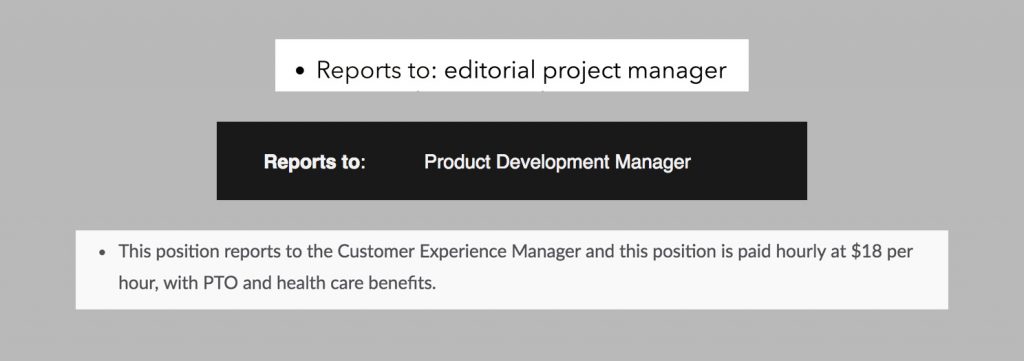
With this information, a little detective work can reveal the name of the hiring manager.
Start off by browsing the company’s website. Look for an about page, company directory, or contact page. These pages are frequently linked at the very bottom of the website. Companies that feature employees on their about page make it much easier to figure out who will be reading your cover letter .
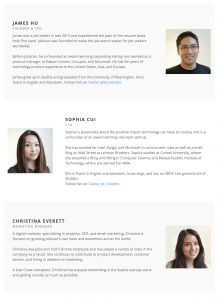
You can also try searching the website. If the website doesn’t have a built-in search bar, use this syntax in Google:
“[position you’ll be reporting to]” site:company website

This will reveal hard-to-find about pages or other mentions of the position in the company’s blog posts, press releases, and other pages.
Search LinkedIn
If a company doesn’t list the hiring manager on their website, LinkedIn is your next best resource.
Start off by searching for the company page on LinkedIn. Once you’re on the company’s LinkedIn page, click “See all X employees on LinkedIn” near the top.

Depending on the company size, you can either browse all positions or narrow your results by adding search terms to the search bar (e.g. “Marketing Manager”) and utilizing the “Current companies” filters on the right side of the screen.
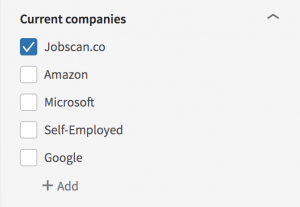
Search for the “reports to” position from the job listing. If it wasn’t provided in the listing, search for keywords related to your prospective department (e.g. “marketing”). If the company uses an intuitive corporate hierarchy you should be able to determine who will be reading the cover letter .
Contact the Company Directly
There is nothing wrong with calling or emailing the company to ask for the name of the hiring manager. Be polite and honest with the administrative assistant or customer service representative. Explain that you’re about to apply for a job and you’d like to know who you should address in your cover letter .
If they aren’t able to provide an answer or transfer you to someone who knows, let it go. The last thing you need is word getting back to the hiring manager that you were pushy with one of their colleagues.
3) Use a More Personalized “To Whom it May Concern” Alternative
You can still personalize your cover letter , even when you don’t know the identity of the hiring manager. Instead of “To Whom It May Concern,” which casts a wide net and is specific to no one, try addressing your cover letter to one specific person.
The most generic version of this is:
Dear Hiring Manager,
But job seekers can often be more specific. Take a look at these examples:
Dear Customer Experience Manager,
Dear Customer Experience Hiring Team Manager,
Some other alternatives include addressing your cover letter to an entire department:
- Dear Engineering Department,
Dear Engineering Team,
OR addressing the entire team:
Hi Jobscan Team,
Dear Jobscan Team,
As with many aspects of the job application process, demonstrating that you put in some extra effort can make a difference. Doing some research before addressing a cover letter contributes to a positive first impression.
8 cover letter salutation examples
Here are eight standard cover letter openings you can choose from. Select the one that best suits the energy of the company you’re applying to and use either a specific name or department depending on the information you have available.
- Hi Mr. Smith,
- Hello Jobscan Team,
- Dear Ms. Whittaker and Team,
- Good morning, Mr. Kennedy
- Good afternoon, Louise,
- To the Jobscan hiring manager,
How to end a cover letter
Just as important as beginning your cover letter is ensuring you end it on a strong note. Your cover letter ending should not be underestimated in its ability to help you move forward in the hiring process. After making your case in the previous paragraphs, you need to end your cover letter with a strong call to action to entice the recruiter to invite you for a job interview.
Madeline Mann , an HR leader in the technology industry and creator of Self Made Millennial , says that while no conclusion will save a bad cover letter , it can distinguish you from another good candidate.
It’s all about enthusiasm, according to Madeline. “Companies want people who want them,” she says. If you can draw to the company’s values and show how interested in working with them you are, that’s a substantial advantage. You want to create a lasting impression by incorporating that enthusiasm in your cover letter ending.
“Companies want people who want them” – Madeline mann
A good conclusion, in fact, should reflect the rest of your cover letter .
Set up the end of your cover letter with a strategic middle section
If you want your cover letter ending to be effective, you first need to build momentum. Most recruiters and career coaches agree that by the time you get to the end of your cover letter , it needs to possess the following three elements:
- It tells a story about yourself
- It shows your value concretely
- It calls the recruiter to action
Julia Reiter, a career coach based in Toronto, suggests that you lead up to your cover letter ending by showing that you understand the company’s current challenges and are equipped to solve them. This will make your cover letter call to action all the more effective.
Although the job description will give you information about what the company is looking to accomplish, it will not help you distinguish yourself from other applicants. Show the company you are willing to go the extra mile by researching the key industry challenges and the particular issues they might be facing (beyond the obvious ones).
For example, you can read articles from industry-related publications and get acquainted with the numbers and statistics about the particular business areas your company is engaged in. By being aware of the particular issues they are facing, you can more easily make your skillset and experiences relevant.
When you talk about your past experiences and accomplishments , make sure you mention the problems the company is facing. For example, if you are applying for a customer success manager position at a Software-as-a-Service company, a relevant issue might be high churn rates.
Instead of writing something like “my experience in customer success makes me confident I will be a great addition to your team,” write something like “When I worked at XYZ company, I was able to reduce the churn rate by 30%. With this experience and my deep knowledge of B2B consumer psychology, I am prepared to ensure we have one of the lowest churn rates in XYZ industry.”
End your letter with a call to action
You may be tempted to write that “I’m looking forward to hearing from you” for your cover letter ending. That isn’t a call to action. For Madeline, the end of a cover letter serves to give one last push and show interest and enthusiasm in a way that stands out.
Likewise, Julia says, “now that the company knows you are aware of their current challenges and are equipped to solve those challenges for them, don’t leave them hanging. Tell them how they can make your skills and experiences a reality on their team. What number can they reach you at for an interview?”
How do you conclude a cover letter ? Here are 3 examples
- “I’m excited to have the opportunity to talk about how I could join your team in its quest for XYZ value. I’m particularly thrilled about XYZ project and would love to know how I can contribute to it.
- “I am keen on meeting with you to see what I can contribute to XYZ company as it moves on in its journey to XYZ goal. I am available at your convenience for a phone call or in-person meeting.”
- “I would love to get your thoughts on what I mentioned. I am happy to hop on a phone call at your earliest convenience to discuss how I can help XYZ company with XYZ issue.”
Read more : Check out our cover letter examples page, which covers a wide range of jobs, industries, and situations.
Mistakes to avoid when ending a cover letter
The mistakes people make when they end their cover letter are often the same ones they made earlier in the piece. However, they can be particularly detrimental to your chances of landing an interview if they constitute the final impression a recruiter has of you.
When ending a cover letter , avoid:
Making it about yourself instead of the company: use sentence constructions that make the recruiter see how the company is going to benefit from hiring you. For example, try to use “you” or “we” instead of “I.”
Sounding generic or robotic: we’ve all seen these cover letters that end with the same plain paragraph. If you write one of those, the last impression you’re giving is not different from those given by all other applicants.
Selling yourself short: the conclusion is your last chance to show off the value you can bring to the company. Emphasize it and use it as a segue into your call to action.
How to end a cover letter with the appropriate salutations
Always remember that recruiters review hundreds of applications for each position. When you are competing with that many candidates, the slightest mistake will disqualify you immediately Although you may not think too much of the salutations, they can hurt your chance of landing an interview.
Make sure your salutations are formal and polite. You should be respectful not only by indicating your appreciation of the recruiter’s time but also by being concise. Do not overdo your salutations and do not employ informal greetings. “Sincerely,” “Thank you for your consideration,” “kind regards,” are all safe options.
When ending your cover letter , you want to balance confidence, respect, and appreciation.
17 cover letter ending examples
Depending on the energy of the business you are applying to, and your own personality, select one of the following 17 cover letter closing options.
- Best wishes,
- Sincere thanks,
- Many thanks,
- Thanks in advance,
- Thank you for your consideration,
- Thank you for your time,
- Respectfully,
- Sincerely yours,
- Yours truly,
- Kind regards,
- With best regards,
- Looking forward to speaking with you,
- With gratitude,
One Final Important note: Cover letters aren’t what they say they are
Cover letters don’t introduce your resume, they supplement it.
In order to get your cover letter into the hands of a hiring manager who cares, your resume has to get past the recruiter and, in many cases, the applicant tracking system they’re using.
Try analyzing your resume below to receive instant optimization tips and recruiter insights from Jobscan so that the time you spend crafting your cover letter isn’t a waste.
The keyword analysis also shows exactly what to focus on in your cover letter .
Jobscan Premium (one month free) even has a cover letter scan feature.
Editor’s Note: A section of this article was originally written in a separate blog post by Léandre Larouche on June 9, 2020. It has been updated and combined with this article as of June 10, 2021.

Related Articles

June 18, 2024

June 17, 2024

June 12, 2024

June 11, 2024

June 4, 2024

Join 2 million job seekers who get bi-weekly job search tips
Get insider knowledge and ready-to-use job-seeking tips and hacks delivered to your inbox.
How To Address A Cover Letter To An Unknown Person
Research is key, general salutations, specific job titles, crafting the rest of your cover letter, make it engaging, tailor your content, show your value, close it out professionally, wrapping up.
Author : Becky is a contributor for theJub . She’s a writing and talent acquisition specialist who loves to apply her skills through creative writing and editing.
Similar Posts
11 top jobs with flexible hours in 2023, what is a good application to interview ratio, high paying business jobs for 2023, 8 best paying jobs in transportation for 2023, 11 high-paying remote jobs for 2023, what is a reasonable commute to work.
- Get the Job
- Resumes and CVs
- Applications
- Cover Letters
- Professional References
Professional Licenses and Exams
- Get a Promotion
- Negotiation
- Professional Ethics
- Professionalism
- Dealing with Coworkers
- Dealing with Bosses
Communication Skills
Managing the office, disabilities, harassment and discrimination, unemployment.
- Career Paths
- Compare Careers
- Switching Careers
- Training and Certifications
- Start a Company
- Internships and Apprenticeships
- Entry Level Jobs
- College Degrees
Growth Trends for Related Jobs
How to address a cover letter when the name is unknown.

Most advice about cover letters instructs job applicants to personalize these documents, but that can be tricky when you don’t know exactly who you are sending the letter to. With a little bit of research, though, you can often find a specific name, along with additional information that will help you land the interview.
Investigate
If the job listing doesn’t provide a specific name to address applications to, do some research to find a name. In some cases, companies might deliberately leave a name off the listing as a test of an applicants’ resourcefulness and willingness to learn about the company. The easiest way to get a name is to pick up the phone. Call the company directly, and say something like, “I am applying for a position in the ABC department. Can you please tell me who to whom I should address my cover letter ?” If you do not get a name, search the company website for a company directory or listing of key personnel.
If your research doesn’t reveal a specific name, the next best option is to address your letter to the general “hiring team.” Very rarely are hiring decisions made by one person, so addressing the hiring team, rather than the more specific “hiring manager,” ensures that you cover your bases. You could also use the generic “Dear Recruiter” or “Dear Recruiting Team.” Don’t address your letter to any variation of human resources, because not all companies have HR departments, and it’s likely that your resume will be reviewed by a department other than HR.
Greetings to Avoid
Never begin your cover letter with “To Whom It May Concern.” Most HR and recruitment professionals note that this is the fastest way to get your resume tossed in the trash, as it tells the employer that you don’t care enough about the job or the company to do even a little bit of research or attempt to personalize the letter. Not to mention, it’s overly formal and doesn’t convey your personality.
Also avoid beginning letters with “Dear Sir or Madam,” or worse, choosing one or the other. Not only does it sound too formal, especially when you are applying for work in a creative field or a startup, but you run the risk of offending someone. At the other end of the spectrum, beginning with “Hello” or even worse, “Hi!” is too informal, and again, shows that you haven’t done any research at all to customize the letter.
Going the Extra Mile
The research you do for the correct name can reveal additional information you can use to customize and personalize your cover letter and application. For example, you might discover that the person doing the hiring went to your alma mater, or shares the same hobby. Even if you can’t find specifics about an individual, researching the company and its mission, vision, goals and priorities can give you some ideas on how to write a better cover letter that gets you noticed.
Related Articles
How to get a resume forwarded to the hiring manager →.

How to Answer Denied Interview →

How to Contact a Hiring Manager →

How to Write a Cover Letter to a Blind Ad →

How to Write a Cover Letter for a Wholesale Job →
How to inquire about a job after the deadline has passed →.

- University of Pennsylvania: Cover Letter Guide for Undergraduates
- Business Insider: The 5 Worst Ways to Address a Cover Letter
- IT World: How to Address a Cover Letter if You Don't Know the Hiring Manager's Name
- Job Star Central: Job Search Guide
An adjunct instructor at Central Maine Community College, Kristen Hamlin is also a freelance writer and editor, specializing in careers, business, education, and lifestyle topics. The author of Graduate! Everything You Need to Succeed After College (Capital Books), which covers everything from career and financial advice to furnishing your first apartment, her work has also appeared in Young Money, Lewiston Auburn Magazine, USA Today, and a variety of online outlets. She's also been quoted as a career expert in many newspapers and magazines, including Cosmopolitan and Parade. She has a B.A. in Communication from Stonehill College, and a Master of Liberal Studies in Creative Writing from the University of Denver.
master1305/iStock/GettyImages
- Job Descriptions
- Law Enforcement Job Descriptions
- Administrative Job Descriptions
- Healthcare Job Descriptions
- Sales Job Descriptions
- Fashion Job Descriptions
- Education Job Descriptions
- Salary Insights
- Journalism Salaries
- Healthcare Salaries
- Military Salaries
- Engineering Salaries
- Teaching Salaries
- Accessibility
- Privacy Notice
- Cookie Notice
- Copyright Policy
- Contact Us
- Find a Job
- Manage Preferences
- California Notice of Collection
- Terms of Use
Explore Jobs
- Jobs Near Me
- Remote Jobs
- Full Time Jobs
- Part Time Jobs
- Entry Level Jobs
- Work From Home Jobs
Find Specific Jobs
- $15 Per Hour Jobs
- $20 Per Hour Jobs
- Hiring Immediately Jobs
- High School Jobs
- H1b Visa Jobs
Explore Careers
- Business And Financial
- Architecture And Engineering
- Computer And Mathematical
Explore Professions
- What They Do
- Certifications
- Demographics
Best Companies
- Health Care
- Fortune 500
Explore Companies
- CEO And Executies
- Resume Builder
- Career Advice
- Explore Majors
- Questions And Answers
- Interview Questions
How To Write A Cover Letter For A Job In 2023 (With Examples)
- How To Write A Cover Letter
- When Is A Cover Letter Necessary
- Free Cover Letter Templates
- Cover Letter Mistakes To Avoid
- Cover Letter Tips
- How To Sell Yourself In A Cover Letter
Find a Job You Really Want In
Cover letters aren’t required with every application, but the majority of managers pay more attention to a candidate who includes a cover letter. This is especially so if you make an effort to tailor your letter to the specific position. It’s important not to just change the names and job positions, but also to show how your professional experience fits with the job.
A good cover letter greatly increases your chance of getting an interview. If you’re looking to write a cover letter, rework a letter that you have, or just want to know what’s involved in the job application process, then keep reading.
Key Takeaways:
A cover letter should be a maximum of one page long, with three to five paragraphs.
Before writing your cover letter, it’s important to reread the job description and include keywords from it.
Do research to figure out who you are addressing, and make sure to keep your greeting gender neutral if you don’t know.
Tailoring your resume to each job can help you stand out from other candidates.

What is a cover letter?
Why cover letters are important, how to write a cover letter, cover letter examples, cover letter template, do’s and don’ts in a cover letter, cover letter faq, expert opinion.
- Sign Up For More Advice and Jobs
A cover letter is a one-page document that describes your professional background, fitness for the role, and interest in the company. Cover letters are a way of introducing yourself to hiring managers in a more engaging way than resumes can.
While your resume spells out the “who, what, where, when” of your relevant experience, a cover letter fills in the “why” and “how.” A good cover letter not only expands on your resume’s accomplishments but also highlights the soft skills that make you an excellent person to work alongside.
While there are no official formatting guidelines for cover letters, hiring managers and recruiters do have certain expectations regarding structure, length, and content.
Writing a good cover letter is important because it is your chance to stand out from other potential candidates. Showing your personality while also matching the tone of the company will help recruiters to visualize how you could fit into the role.
Simply submitting a cover letter isn’t enough though. Each cover letter you write should be specifically tailored to the job you’re applying for (just like resumes). It’s essential that you show the reader that you’ve done your homework and understand exactly what function you’d be serving if hired. You do that by providing examples of past work experiences that directly relate to the responsibilities of the new job.
Cover letters are inherently unique based on who’s writing them and for what position. However, as a cover letter is a business letter, it has an expected format that it should follow. This is important because you want the hiring manager to be able to look over your cover letter quickly and understand your qualifications and interest in the position.
Here’s the standard way that a cover letter should be formatted and what to include:
The header. The header of your letter is where you should input all of the contact information for yourself and the hiring manager . Do you best to address it directly to the person who’ll be reading the letter — typically either the hiring manager or HR manager.
Traditionally, you should include both your name and address and the employer’s name and address. However, as the majority of applications are online, the employer’s address is often omitted. But a traditional cover letter’s heading would look like this:
Page Roman 444 Frog Rd. Marigold, TX, 10987 August 27th, 2021 Chris Morgan Marketing Manager New Media Company 833 Rune Rd. Marigold, TX, 10987
If you’re emailing your cover letter, you can simply include your name, telephone number, email address, and fewer address details (just your city and state will suffice). You can also include a zip code if you live in a big city with multiple zip codes.
Jessica Dancer jessica. dancer @email.email | (555)-444-3333 | Colombus, OH 43110
Be sure to use a professional-sounding email address that’s not associated with your current or past employer. It’s disrespectful to both your current employer and the company you’re applying to, and will likely hurt your chances of being invited for an interview.
The greeting or salutation. Traditionally, the best salutation would be to use Dear Mr./Ms. [Last Name]. Make sure that you know the person’s gender when doing this, however, as you don’t want to misgender the hiring manager. Using “Dear [First Name] [Last Name]” is becoming more popular for this reason, patriotically among younger workers.
Dear Mr. Morgan, Dear Mrs. Smith Dear Ms. Conner
Avoid using generic greetings such as “To whom it may concern” as it’ll look like you didn’t bother to personalize the letter (even if you did.) That particular phrase has become somewhat controversial as well, so if you need to put a generic address — if you can’t find the hiring manager’s name, for instance — use something else, such as:
Dear Hiring Manager Dear [Department] Manager Dear [Title of the Person You’d Report to if Hired] Dear [Department] Hiring Team
Opening paragraph. The opening of your professional cover letter should instantly grab the attention of your reader . Try to lead off with one of your most relevant and impressive accomplishments.
Open strong . Open with a statement other than your name or stating your interest in the position. Lead with an interesting experience or achievement that directly relates to the new position.
Convey your personal value. There are always other qualified applicants with similar skills, so it is key to express why you personally would bring value to the organization. Give specific details as to the value you brought in a previous position, and how that could transfer to the new role.
Show your enthusiasm. Recruiters want to hire candidates who are excited about the position. Express enthusiasm and convey why you are passionate about the role. This is another opportunity to share a quick personal anecdote related to the job.
Keep it short. All of these points in your opening paragraph shouldn’t be more than a sentence or two each. You don’t want your introduction to be too long, as you want the reader to be able to quickly go through your cover letter.
As a Content Writer with a passion for travel and literature, I was thrilled to see the Senior Content Writer position open up at BookFly. My past experience driving organic traffic by 23% YoY to the travel website, XTravel, would translate perfectly into the position’s stated goals from the job description.
First body paragraph. Here is where you should really sell yourself across several areas. Showcase how your personality traits, such as being honest or having the ability to work under pressure, make you a good fit.
Emphasize transferable skills. Explain how the skills you’ve cultivated make you the perfect fit for the role. This can include collaborative work you’ve done in the past, a leadership role you had that drove results, or interpersonal skills.
Revisit the job description. Make sure to pull relevant skills from the job description and put them in your cover letter. If the hiring manager spent the time to list those skills, they’re going to be looking for candidates that have them.
It also helps with applicant tracking systems that may sift through cover letters looking for keywords.
Don’t skimp on personality traits. These are especially important if you don’t have a lot of experience. Desirable skills such as ambition, dedication, and getting work done on time are good for both entry-level positions and if you’re making a career change.
I have a passion for content creation and a deep understanding of the content cycle, from ideation to promotion. My years in the digital publishing world have crafted my ability to drive killer CTR and resonate with an audience. Not only did CTR jump by 2.1% in the months after I was brought on board, but it had a knock-on effect on social media engagement, which rose by 8% in the same time frame. I believe good content has its roots in good data. This is why while at Media Company I created a content-marketing dashboard to highlight KPIs like those mentioned above. The dashboard allowed us to take advantage of wins more rapidly and avoid repeating losses.
Second body paragraph. Just as an employer wants to know why you’d want the role, they also want to know why you’d want to work at their company. Do your research and learn more about the core values of the company. Discuss how they align with your own.
Check the company’s website but also start to explore LinkedIn for greater insights. Employers want to make sure that you fit into the overall culture, and this is also something you should consider for yourself. However you feel you fit into the work culture, explain to the recruiter why. Paint a picture of how you’ll be better from the company, and how the company will also benefit.
I thrive in a fast-paced environment and excel at creating structures from scratch. I spearheaded our SEO efforts, developing workflows and systems to ramp up content production from zero. BookFly’s commitment to core values of “collaboration and imagination” aligns with my own preferred approach to tackling projects and dreaming of big ideas.
Closing. The closing of your letter is your final impression to the hiring manager, and therefore should clearly express your eagerness to take on the position. You don’t need to rehash all of the accomplishments and skills highlighted in previous sections. Consider this more of a statement of intent.
First, express gratitude that they took the time to consider you for the job by making it all the way through your letter. Then, quickly remind them of the benefits that you can bring to the role and company.
Finally, your closing should state a clear call-to-action (CTA) for the recruiter to take next, such as calling you to schedule an interview. Being confident and direct at the end of your cover letter helps to close the deal.
I look forward to learning more about how the Senior Content Writer operates within BookFly and the current content process. Thank you for taking the time to consider my application. Sincerely, Jessica Dancer
With thousands of cover letter templates on the internet, you want to make sure you choose the right one. Here’s a basic format of what a good cover letter will contain:
Jessica Dancer [email protected] | (555)-444-3333 | Colombus, OH 43110 Dear Mr. Morgan, As a Content Writer with a passion for travel and literature, I was thrilled to see the Senior Content Writer position open up at BookFly. My past experience driving organic traffic by 23% YoY to the travel website, XTravel, would translate perfectly into the position’s stated goals from the job description. I have a passion for content creation and a deep understanding of the content cycle, from ideation to promotion. My years in the digital publishing world have crafted my ability to drive killer CTR and resonate with an audience. Not only did CTR jump by 2.1% in the months after I was brought on board, but it had a knock-on effect on social media engagement, which rose by 8% in the same time frame. I believe good content has its roots in good data. This is why while at Media Company I created a content-marketing dashboard to highlight KPIs like those mentioned above. The dashboard allowed us to take advantage of wins more rapidly and avoid repeating losses. I thrive in a fast-paced environment and excel at creating structures from scratch. I spearheaded our SEO efforts, developing workflows and systems to ramp up content production from zero. BookFly’s commitment to core values of “collaboration and imagination” aligns with my own preferred approach to tackling projects and dreaming of big ideas. I look forward to learning more about how the Senior Content Writer operates within BookFly and the current content process. Thank you for taking the time to consider my application. Sincerely, Jessica Dancer
If you’re putting the cover letter in an email, you can omit putting the contact information at the top and instead include it below your signature. You want to make sure to include your name, phone number, and LinkedIn link, as well as a professional portfolio , if applicable.
Dear hiring manager: I am writing about the position of veterinary receptionist at Pet Care Clinic posted on indeed.com. I am a certified dog trainer with both Petsmart and Petco, allowing me insight into animal behavior. I’m also an aspiring novelist , making me a fast, experienced typist as well as adept with Microsoft Word and Apple Pages. Since I’ve worked at pet stores for several years, I am familiar with different kinds of animal and animal care, as well as building a rapport with pet owners. While I enjoy working with animals and my coworkers, I would like to move into a business where I can continue to learn and build on my experience. I would also like to work for a smaller business. Veterinary medicine has always interested me, and I very much enjoy learning new things. I’m eager to learn more about it in order to help customers make the best choices for their pets. I’ve always enjoyed working with animals, even before I was able to get a job that allowed me to. I grew up with dogs and cats, so I’m comfortable and familiar with their behavior. Being a pet owner myself, I’m able to understand what customers are looking for in a veterinary clinic and tailor the experience to their needs. Thank you for your time and I look forward to hearing from you. Sincerely, Michelle Bolivar Email: [email protected] Phone: (555) 545-9706
[your contact information] [date] Dear [Hiring Manager], I’m writing to apply for the open [position] at [company] that you posted [place job ad was found]. I believe that my [relevant experience] would be an excellent fit with [company name]. I have long been interested in [specific industry/department], and particularly your company because [why you’re interested in the company/awards they have won/accomplishments]. That experience and [relevant skills] that I’ve cultivated as a [current position] for [time worked in position or industry] will be an asset to the company as it’ll make me effective [at the job/particular aspect of the job]. The [responsibilities required in the job description] will be a [challenge/interesting task] and I look forward to making use of my [relevant skills]. I excel at [working with a team/working alone] and I want to use my expertise to further [company’s] success. I am excited about the possibilities this position holds, and I believe that my qualifications ensure I’d be an asset to your team. I look forward to being able to further discuss the details of the position and my qualifications with you in an interview. Please let me know if you require further information from me. Thank you for your time and I look forward to hearing from you. Sincerely, [Your name] [Your contact information (if it’s an email)
Knowing the proper format of a cover letter is the most important factor, of course, but there are some additional dos and don’ts that if you follow can make your cover letter better. It’s during the editing process, it’s important to go over and make sure that you haven’t made any common mistakes that’ll hurt your chances.
Here are 10 dos and don’ts for writing a good cover letter:
Do’s:
Do start by scanning the original job posting for keywords you can include in your letter.
Do be proud of your accomplishments and make sure to highlight them.
Do clearly express why you would be an asset to the organization.
Do tailor your cover letter to every hiring manager and position that you apply for.
Do try to find unique experiences, but make sure to always discuss measurable and relevant results.
Don’ts:
Don’t feel the need to lie about your skills or accomplishments. One of the worst mistakes to make is being caught in a lie.
Don’t copy and paste a template and only change your name and job titles. Recruiters will not see the value in a plug-in-play cover letter that has been used by multiple applicants.
Don’t forget to be direct and include a call to action.
Don’t make your cover letter too long. Similar to your resume, you want the reader to sum up who you are and get a quick explanation of why you’re a good fit.
Don’t forget to proofread. Grammatical errors on a cover letter and resume are a quick way to get your packet in the “no pile”.
What do you write in a cover letter?
In a cover letter, you should mostly write about impressive accomplishments from past jobs or academic experiences that relate to the job you’re applying for.
What is the purpose of cover letter?
The purpose of a cover letter is to help a hiring manager see why your background makes you suitable for the role in question. While a resume lists achievements, educational background , and skills , it doesn’t give the reader an idea of your actual expertise or personality.
A cover letter allows you to share your approach to work, as well as your ability to communicate your value effectively. A good cover letter makes it easy for a reader to think “I could imagine this person working for us.”
How do you write a simple cover letter?
To write a simple cover letter, start with the header and greeting we outlined above. Next, state your interest in the position (give the exact job title as listed in the job description) and mention your years of industry/job experience.
To keep your cover letter simple, you can now briefly mention in 1-2 sentences or 3-4 bullet points what parts of your background are most important for the hiring manager.
Finally, thank the reader for considering your application, and sign off as usual (e.g., “Sincerely, [full name]”).
What is the best way to start a cover letter?
The best way to start a cover letter is with an accomplishment that speaks directly to your ability to provide value for the company. Other good strategies include describing your long-standing passion for the field, mentioning an important reference at the company, or referring specifically to challenges the company is currently facing.
Do you introduce yourself in a cover letter?
No, you do not introduce yourself in a cover letter. By that we mean you do not say “My name is so-and-so” — you simply jump into your background and why you’re interested in the position.
Your name can be found at the bottom of the cover letter, as well as the header, your email address, and your resume, so there’s no need to force it awkwardly into your cover letter’s opening.
How do you end a cover letter?
To end a cover letter, thank the reader for their time and/or consideration, express enthusiasm for further correspondence and conversation, and sign off with a standard closing like “Sincerely.”
How long should a cover letter be?
A cover letter should be a maximum of one page long, with three to five paragraphs. Half a page is the shortest that your cover letter should be.
Harvard Business Review — How to Write a Cover Letter
University of Washington — Writing the Cover Letter
What’s a quick cover letter tip?

Michael Akbar Vice President Certified Professional Career Coach
Use your six seconds to show the employer in a tailored cover letter and resume that you understand their pain and will make their lives better if put in the position.
How useful was this post?
Click on a star to rate it!
Average rating / 5. Vote count:
No votes so far! Be the first to rate this post.

Chris Kolmar is a co-founder of Zippia and the editor-in-chief of the Zippia career advice blog. He has hired over 50 people in his career, been hired five times, and wants to help you land your next job. His research has been featured on the New York Times, Thrillist, VOX, The Atlantic, and a host of local news. More recently, he's been quoted on USA Today, BusinessInsider, and CNBC.
Matt Warzel a President of a resume writing firm (MJW Careers, LLC) with 15+ years of recruitment, outplacement, career coaching and resume writing experience. Matt is also a Certified Professional Resume Writer (CPRW) and Certified Internet Recruiter (CIR) with a Bachelor of Science in Business Administration (Marketing Focus) from John Carroll University.
Recent Job Searches
- Registered Nurse Jobs Resume Location
- Truck Driver Jobs Resume Location
- Call Center Representative Jobs Resume Location
- Customer Service Representative Jobs Resume
- Delivery Driver Jobs Resume Location
- Warehouse Worker Jobs Resume Location
- Account Executive Jobs Resume Location
- Sales Associate Jobs Resume Location
- Licensed Practical Nurse Jobs Resume Location
- Company Driver Jobs Resume
Related posts
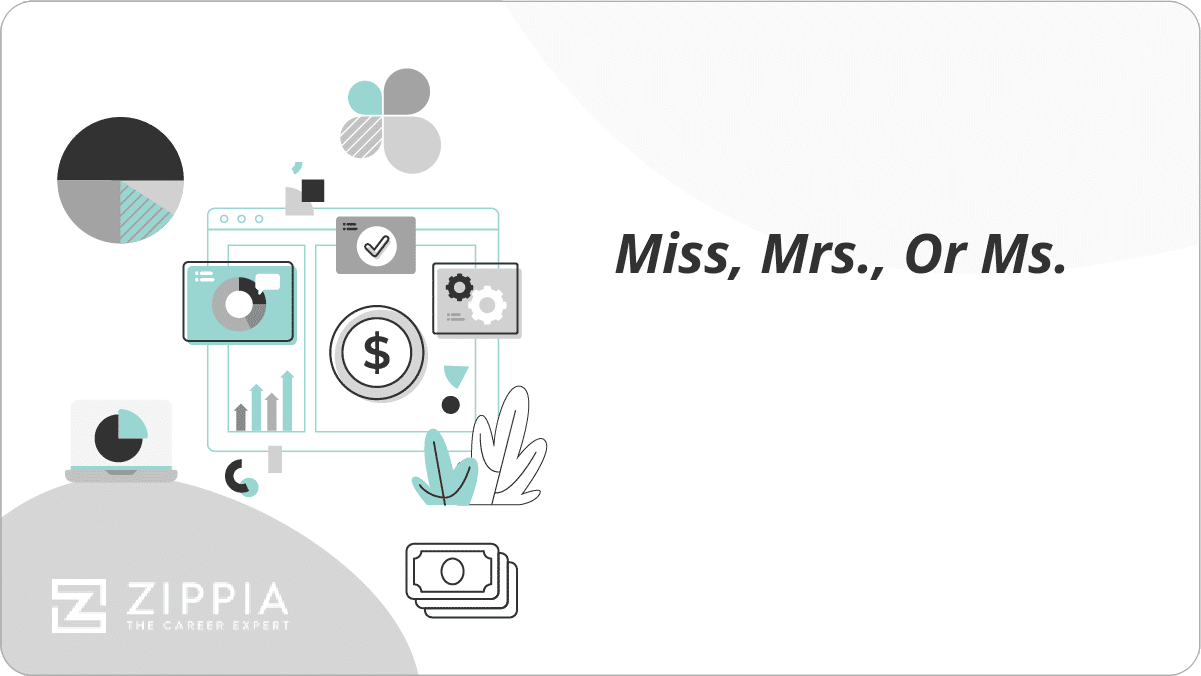
Miss, Mrs., Or Ms.: When To Use Each

Cover Letter Examples for Every Situation

How To Write A Short Cover Letter (With Examples)

When Are Cover Letters Necessary (With Examples)
- Career Advice >
- Cover Letter >
How to Write a Cover Letter Without a Job in Mind
- Cover Letters
- ')" data-event="social share" data-info="Pinterest" aria-label="Share on Pinterest">
- ')" data-event="social share" data-info="Reddit" aria-label="Share on Reddit">
- ')" data-event="social share" data-info="Flipboard" aria-label="Share on Flipboard">
How to Write a Cover Letter to a Previous Employer
How to write a letter requesting a future job opening, how to write a sample letter accepting an interview opportunity.
- How to Describe Focus & Customer Skills on a Resume
- How to Write a Resume & Cover Letter for a Quality Control Inspector
When you're getting a jump-start on the job-seeking process, crafting a detailed, persuasive resume and cover letter is likely the No. 1 item on your agenda. While it's fine to draft a generic cover letter that doesn't pertain to just one specific job, ideally, you'll eventually want to customize and tailor the letter to the employer you're sending it to.
All-Purpose Introduction
The introductory portion of your cover letter should indicate the type of job you're applying for, where you heard about the company and why you think you'd be a good fit. Example:
I was very excited to learn that COMPANY NAME is hiring for the position of BLANK. I became aware of your opening from BLANK, and I feel I’d be a great fit, as I’ve been working in BLANK industry for five years.
All-Purpose Credentials
The next section of your cover letter should detail your work experience, using care to reference the key elements of the job description, and touch on the main hiring criteria the employer lays out in the listing. These will vary from job to job, but your all-purpose cover letter template should follow this basic format. Here are some things to include:
- Your experience
- Specialized skills
- Significant achievements
I've worked as a department store manager for 15 years. I have experience in merchandising, handling vendors, hiring and training and overall operational functions. In my last role, I oversaw an expansion effort that doubled the size of our company.
Soft Skills
Regardless of the type of job you’re applying for, many of the same soft skills will apply. These include your ability to collaborate, think critically, make decisions and be detail oriented. Use this type of verbiage:
I consider myself to have exceptional time management skills, and I enjoy working both independently and as part of a team. I have a good temperament for management, and I strive to ensure my staff is happy, trained and fulfilled in their roles.
Again, reference individual job listings to tweak this verbiage based on the requirements of the particular position you eventually use it for.
Finish Strong
One of the key ways to customize your all-purpose cover letter to an individual employer is to close with a strong statement that outlines why you want the job and why you’re the right candidate.
I've always held this organization in high regard and would love the chance to be part of such a respected business. I believe you'll find my dedication, work ethic and loyalty is well in line with the high standards you’ve established for your company.
When you're drafting a somewhat generic cover letter to alter and use in different circumstances, use extra care in proofreading it before you send. You don’t want to inadvertently reference Company A in a letter you’re sending to Company B.
- Forbes: I've Read More Than 300 Cover Letters, And This Is How I Decide If They're Good Or Bad Within Three Minutes
- CNN Money: How to Write a Killer Cover Letter
- Use your word processing application's mail merge feature to create letters for several different addressees. Include the name of the company, the recruiter's name if you have access to it, and the street address, city, state and zip for each letter. Don't address letters "to whom it may concern." It's an impersonal greeting that tells the reader right away that it's probably just a form letter. If you cannot access the name of the recruiter or hiring manager, address the letter to "Dear XYZ Corporation Recruiter."
Lisa McQuerrey has been an award-winning writer and author for more than 25 years. She specializes in business, finance, workplace/career and education. Publications she’s written for include Southwest Exchange and InBusiness Las Vegas.
Related Articles
How to write a simple application cover letter, how to make a good application letter, how to write a letter looking for work, how to create a resume for a current employer, how to write a generic cover letter for multiple purposes, example of a cover letter for an hr generalist, how to write a cover letter to a company that does not have a job opening, email format for a follow-up resume, how to write a letter of appreciation for a job offer, most popular.
- 1 How to Write a Simple Application Cover Letter
- 2 How to Make a Good Application Letter
- 3 How to Write a Letter Looking for Work
- 4 How to Create a Resume for a Current Employer
Get the Reddit app
Get help with your resume! Please read the Wiki before posting. Check out the COMMUNITY BOOKMARKS for helpful info.
When you don't know who you're writing a cover letter for... who do you address? Try this!
Cover letters seem to be a big issue with a lot of people writing job search documents. One of the more challenging parts I used to struggle with is... who the heck do you address your cover letter to if you don't know who is reading it? Is it HR? Is it the hiring manager?
In my opinion, "To whom it may concern" is too informal and lacks a lot of personality, plus it's ridiculously boring to read. "Dear HR at Company X " or "Dear Hiring manager" seems like it's targeting too specific of an audience if you want them both to read it... so who do you address it to?
Dear Company you're applying to
If I'm applying to Google, " Dear Google ". If I'm applying to Jack's Country BBQ, "Dear Jack's".
Using this approach addresses everyone that is reading your cover letter and it isn't boring. Furthermore, this approach also conveys a "family" or all-inclusive audience as if you are trying to be apart of it. The truth is, most companies love to promote a sense of team effort and addressing them as if they have that makes you stand out as someone who recognizes that. The HR departments of companies are also the ones who typically promote this sense of togetherness.
If you know exactly who is going to be reading your cover letter and/or resume, then it's good to address them by their name. However, if you don't know for sure, it's far better to use "Dear Company " because it allows you to stand out.
Feel free to share your thoughts below. Hopefully this helps some of you struggling with the dreaded cover letter....

COMMENTS
Even if you don't know the recipient's name, it's crucial to keep your language and tone professional throughout your cover letter. Provide examples of well-formatted cover letter salutations. Example 1: "Dear Hiring Manager," Example 2: "Dear IT Director," Example 3: "Dear Ms. Taylor Smith,"
Include a header. In the top left corner of your letter, write your full name, address and contact information, followed by the date, company name, address and hiring manager name and title, if you know it. Write a greeting. Use a formal salutation such as "Dear" followed by the title and last name of the manager most likely to be hiring for ...
Job Application Letter Sample and Writing Tips for a Role That's Not Advertised. Mention your contacts. If you know someone at the organization, mention this at the beginning of the cover letter. Having a contact at the company is a great way to get your foot in the door, even if the company isn't actively hiring. Use paper or email.
Not every business has HR take care of all hiring tasks, especially if it's a smaller company. Examples of how to address a cover letter: Dear Sir or Madam. Dear Hiring Manager. Dear Talent Acquisition Team. Dear [Company Name] HR Department. Dear [Company name] Hiring Manager. Dear Human Resources Manager.
Who to address your cover letter to if the recipient is unknown. Opening your cover letter by addressing the hiring manager by name is always preferable to a generic greeting.It's worth spending a bit of extra time trying to find the name of a contact person, because this shows that you've done your research and signals to employers that you're serious about the job.
Here are five steps on how to address a cover letter without a name: 1. Remain gender neutral. The first step to addressing a cover letter without a name is to use gender-neutral identifiers. Deepti Sharma spent several years in the corporate world before following her entrepreneurial spirit and starting her business as a human resources (HR ...
How to address cover letter without a name. Imagine that you've found a position you want to apply for and are working through your cover letter. There's just one problem — you're not sure how to address your cover letter. Unknown recipients can complicate the application process, especially when you want to set a great first impression.
How to Address an Email Cover Letter. Use these tips for addressing a cover letter email: Subject Line: 5-10 words—"Job Application for" + position you're applying to. Start with a cover letter salutation like Dear Dr. Manzanilla, Put your name, email address, and phone number at the end.
Here are some steps you can follow to help draft a cover letter when you're not sure of the hiring manager's name: 1. Research the company. The first step when writing a cover letter when you don't know the hiring manager's name is to conduct research using company sources. Try checking the "About" or "Staff" sections of the employer's website ...
To help you figure out the name of the cover letter's recipient, here are some tips: Tip #1: Check the company's website. If you know the company's name and they have a website with contact information, that's usually the best place to start. Tip #2: Review job listing sites.
Cover Letter Salutations. These can also be formal or casual and again, it is better to stay formal if the applicant is unsure. "Mr." and "Ms." can be used, but "Mrs." and "Miss" should be avoided as they assume that the recipient is married or not married. Although using "Dear" or "Hello" in front of the name is ...
Dear Prof. Umansky, Dear Dr. Nolan, Dear Mr. Lunden, Dear Ms. Oyelowo, Remember that being professional is of utmost importance. Never address your cover letter with casual greetings like "Hi," "Hey," or "Greetings.". PRO TIP. Check out our cover letter examples for more ways to address your cover letter. Take advantage of our cover ...
Rule #1: Address your cover letter to the hiring manager using a formal, full-name salutation (if possible). For a cover letter, you should always default to addressing it to the hiring manager for the position you're applying to. Unless you know for sure that the culture of the company is more casual, use the hiring manager's first and ...
Dear Hiring Manager, But job seekers can often be more specific. Take a look at these examples: Dear Customer Experience Manager, Dear Customer Experience Hiring Team Manager, Some other alternatives include addressing your cover letter to an entire department: Dear Engineering Department, Dear Engineering Team,
Here are the most common ways to address a cover letter without a name: To Whom It May Concern. Dear Human Resources Director. Dear Hiring Manager. Dear Recruitment Manager. Additionally, if you want to add a personal touch, address your cover letter to your prospective department or manager.
Addressing a cover letter to an unknown person can feel daunting, but with the right strategies, you can still create a powerful, personalized cover letter that leaves a lasting impression. Your goal is to stand out from the crowd, and a well-crafted cover letter is your ticket to doing just that. So, get out there, and start making an impression!
Go General. If your research doesn't reveal a specific name, the next best option is to address your letter to the general "hiring team.". Very rarely are hiring decisions made by one person, so addressing the hiring team, rather than the more specific "hiring manager," ensures that you cover your bases. You could also use the generic ...
Using a person's name in direct communication helps to establish a connection. So it's no wonder you should use it in the cover letter address! Start with Dear + recipient's first name or their first and last name. Use honorific titles such as Mr. or Ms. only if you're 100% certain of the recipient's gender identity.
Next, state your interest in the position (give the exact job title as listed in the job description) and mention your years of industry/job experience. To keep your cover letter simple, you can now briefly mention in 1-2 sentences or 3-4 bullet points what parts of your background are most important for the hiring manager.
Finally, the candidate keeps the focus on their professional qualifications by listing specific accomplishments from their previous job, and explains how these accomplishments are relevant to the position. 5. Career change cover letter example. Writing a cover letter for a job in your current industry is pretty straightforward.
2. Open with a salutation. Find the name of the hiring manager or recruiter if you can, and address your cover letter to that person. Even if the letter is generic, addressing it to a specific person indicates attention to detail and consideration. Begin with a formal salutation, such as "Dear Mr. Cortez.".
These will vary from job to job, but your all-purpose cover letter template should follow this basic format. Here are some things to include: Your experience. Specialized skills. Significant achievements. I've worked as a department store manager for 15 years. I have experience in merchandising, handling vendors, hiring and training and overall ...
Before writing the body paragraphs and the "Dear Company", I'm wondering about the beginning portion of the cover letter where I write my information and the information of the company I'm applying to. So this is my template for the beginning of my cover letter, Name Address Phone # Email Date Name of Employer Position Company Address
A cover letter is more than a resume in paragraph form. 3 The format, content and purpose of a cover letter are highly individualized. • Follow basic professional writing standards, paying special attention to differences in uploading a cover letter into an online application or using your letter as the body of an email message.
The headline on the image says, "Cover letter format" A woman sits at a table writing on a piece of paper. There's a simple cover letter represented by lines. On one side of the cover letter, there are labels for the sections of the cover letter. The labels are: 1. Date and contact information 2. Salutation/greeting 3. First, introduce yourself 4.
Using keywords from the job ad in your cover letter (when applicable, of course) can help your letter pass through applicant tracking systems (ATS) that scan for relevant terms and qualifications. By incorporating keywords from the job description, you increase the chances that your application is recognized as a match for the position. ...
So let's talk about how to do cover letters right., First, understand the point of a cover letter., The whole idea of a cover letter is that it can help the employer see you as more than just ...